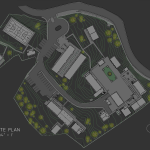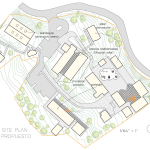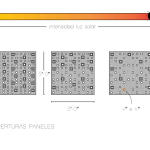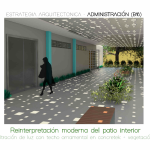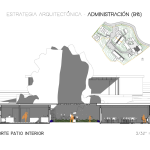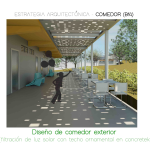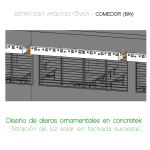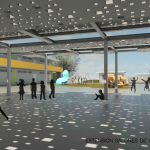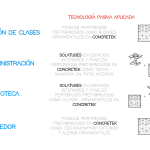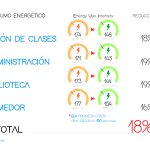Luz Natural: Tecnologías e Identidad Tropical en las Escuelas Tipo en
Puerto Rico (Natural Light: Technologies and Tropical Identity in Type
Schools in Puerto Rico)
“Al encontrarnos rodeados por la modernización constante y acelerada que caracteriza al siglo XXI, es momento de reflexionar sobre cómo queremos progresar como sociedad y qué métodos estamos utilizando para lograrlo”. -Badía, A.
“As we find ourselves surrounded by the constant and accelerated modernization that characterizes the 21st century, it is time to reflect on how we want to progress as a society and what methods we are using to achieveit”. -Badía, A.
Designer: Adriana Badía Piazza
Thesis Director: Arq. Mayra Jiménez
Consultants: Arq. Esteban Senney & Arq. Cristina Algaze
Project Date: May 2016
Location: Escuela Segunda Unidad José R. Barreras – Morovis, PR
TOS[er]: Jomarly Cruz Galarza
Posted Date: ________ 2020
Can you remember your school years? How was the lighting like in the classroom, library, or any additional space? Was artificial light abundant? Adriana Badía’s thesis is precisely focused on the study of natural light in the educational space. The purpose of this thesis is to analyze design strategies where natural light not only embellishes the educational space but also makes it functionally more effective. Natural light aids learning, increases productivity, and improves student achievement. The control of lighting has a direct relationship with the thermal control of a building. It is evident that the design of light in architecture is a fundamental aspect. Badía adds that: “There is great value in design that achieves harmony in the lighting of the space, where theuse of artificial light is a compliment, not a dependence”.
As a reaction to modern tropical architecture, where artificial light predominates, the research seeks to represent our Tropical Identity, within the educational typology. Through technology, the study proposes strategies to reduce energy costs and the environmental impact that come with the use of artificial lighting. As Badía points out: “There are so many positive consequences that continue to emerge when maximizing one of the best natural resources we have, that its inclusion when making architecture should not be considered an “additional effort”.” Global warming is one of the phenomena identified by Badía, as a promoter of a general pro-environmental attitude in the architecture of the XXI century. This attitude is reflected by some contemporary architects with the terms “eco-friendly”, “green” and “sustainable”. However, Badía suggests that the direct relationship with the environment is one of several elements that must be taken into account. Sometimes the cultural identity of the human being and their quality of life is not considered, causing standardized design strategies without considering the immediate environment. Badía reinterprets the aforementioned through the term critical regionalism, developed by the architect Kenneth Frampton. Consequently, she describes it as the beginning of a crisis of architectural cultural identity.
To address this approach, one of the main aspects that are emphasized in the document is the concept of “tropical architecture” and its implications. Some of these are lighting time, solar angles, climate (hot-dry or hot-humid), vegetation, proximity to the sea, and changes in the wind direction, among others. In the hot-humid zone, where Puerto Rico is located, architectural strategies should focus on avoiding the generation of more heat and promoting cross ventilation during the day and night. Badía emphasizes: “Especially in Puerto Rico, where natural light could be considered an abundant architectural element, a design must be worked on that, in addition to harmonizing the exterior with the interior, can use light as an element of cultural expression”.
Within the historical context, Badía makes reference to architects such as Henry Klumb, Richard Neutra y Toro y Ferrer, who with their works in the mid-20th century demonstrated the tropical identity of Puerto Rican architecture. These manifested in their designs an effective relationship between the interior and the exterior, including architectural elements that encouraged cross ventilation and natural lighting. In support of the above, Badía selected three (3) case studies: the Baan Nong Bua School (Chiang Rai, Thailand), the José de Diego Ecological School (Dorado, Puerto Rico), and the José R. Barreras Second Unit School (Morovis, PR). This last, selected as the intervention site, is located in the mountain town of Morovis and lacked efficient climate-based interventions. According to the State Historic Preservation Office (SHPO), within the 17 buildings that make up the educational complex, two (2) structures are historic and must be maintained. Badía carried out a graphic analysis of energy consumption and light quality before intervening in the school and after applying the design strategies. The digital programs Sefaira Architecture and Ecowho Passive Solar Eaves Calculator were used as tools to evaluate and calculate the presence and intensity of light at three times of the school day: in the morning (9:00 a.m.), at noon (12:00 m) and in the afternoon (3:00 pm). Also, as a design guide, the lighting standards of the Illuminating Engineering Society of North America (IESNA) were used.
Badía worked with two types of design interventions:
1. site level – to create new spaces for interaction in the outdoors
2. interior spaces – classifying structures according to the program to maximize the use of natural lighting according to the activities carried out.
The purpose of this was to use passive technologies and effective design strategies to naturally illuminate the space and dramatically reduce the use of artificial light. To achieve this goal, Badía reinterprets elements of traditional tropical architecture such as the ornamental block, the traditional balcony, the traditional interior patio, and an ornamental ceiling. At the same time, it mainly uses two products: prefabricated panels in Concretek and Solatube. Badía’s decisions caused a reduction of almost 20% in the regular consumption of energy in a school day and a significant economic saving in the school. Badía concludes by stating that: “Not only was the experience inside the educational space transformed, but also a new architectural identity was given to the school experience, worthy of being representative of its immediate tropical Puerto Rican environment”.
TOS[er] reaction:
Why don’t we make the most of our context to have more naturally lit spaces? As future professionals, we must always keep in mind our context, the occupants, and the natural resources that we can use, but in the same way know the cultural identity of the place. With this colleague’s thesis, it was proved that we must consider a set of aspects, not just the environmental element. As designers it is vital that we take into consideration the natural and renewable resources that we have at hand in our regions. Badía teaches us that natural light is fundamental to good responsible design and that architecture must reduce its impact on climate change. As the author asks: How much importance are we really giving to the design of light in architecture? That is the question that we all really must ask ourselves and react to through our projects.

